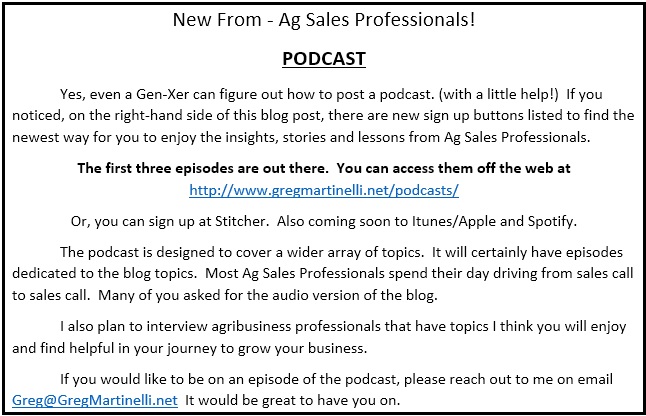Doing is more important
The Information Age began in the 1970’s and is still going stronger than ever. So, it would make sense that knowing a lot of information would give someone or a company an advantage. Not necessarily so says, Pfeffer and Sutton in their 2000 book titled, “The Knowing-Doing Gap”. A great book on how companies and leaders mismanage, by not turning knowledge into actions. While this book is written for the leaders of companies, it also applies to the individual, especially the remote salespeople like most of us in agribusiness. With a home office and a large geography to cover, we have the freedom to choose what we do and where we go every day. It takes a lot of self-discipline to do what we know we should do and bridge the knowing-doing gap. See if any of these situations cause you to have your own personal knowing-doing gap in your selling.
To understand this gap, look no further than our own personal habits. We know how to eat and exercise. Yet, we eat too much and exercise too little. We know we shouldn’t talk on the phone and drive. Yet half the drivers on the highway are talking or texting as they drive. We know we should pay attention during conference calls. Yet, we continue to multi-task by checking email or doing paperwork while “listening”.
In sales, the same is true. We know we will lose customers over time, which means we need to prospect and cold call to grow our territory. Yet, we continue to find reasons to avoid the uncomfortableness of cold calling. We find reasons to call on current customers. Feeling justified that we are doing the right thing, we claim we just need more hours in the day to call on prospects. In the end, we do what we prioritize.
As a sales trainer, I see this every day with selling skills and territory management. Pre-call planning is one of the first casualties as a salesperson matures in their territory. “I know this customer. I just need to stop in and talk for a bit to get him to buy. I don’t need to spend my time planning a visit,” are the comments I hear. To be transparent, I had some of those same thoughts myself when on territory. Ask yourself, “What activities do I know I should do, but don’t?”
Let’s examine some of the causes of how this gap develops between knowing what to do and actually doing it.
Cause #1: Talk is cheap. The first cause of not doing is talking too much. In a company, this happens when talk is rewarded more than actions. Those that talk the most or loudest get their way. Meeting after endless meeting is needed to make a decision. Think about your own personal decisions to act. Maybe you write good lists, make great plans and tell others what you plan to do. Then you derail those plans by spending time on email, social media or somebody else’s emergency situation. As a new manager, we might run around like a fireman and put out fires all day long. We feel a sense of accomplishment after ‘fixing” things all day.
The result? No time for the big tasks. We tell ourselves, “I can’t stop to work on long-term projects, even if they are more important to our future success than all the urgent things I do.” There’s very little time left in the day after solving everyone else’s problems.
Cause #2: Routine versus thinking. This is a natural part of getting comfortable in our jobs. While we enjoy the newness of a job at first, we also feel a certain sense of security in knowing what is expected and having some routine in our schedule. In a company, it might sound like “That’s our Culture” or “That’s how we do it here.” Some of this is necessary to understand how to do our jobs and to add some semblance of sanity to a busy workload. However, this can easily go too far and sound like, “That’s how we have always done it” or “We tried that once. It didn’t work.” The desire to be organized and develop a routine can quickly kill creativity and turn into a rut.
For a salesperson, this might be routinely calling on customers on a given day of the week. Why? “Because they are expecting me that day.” Why? “Because I always go there that day” By the third or fourth “Why”, you begin to understand the salesperson is comfortable making a call on that customer every week on their designated day. It gives a salesperson a reason to leave the house. He feels like he is doing something besides sitting in his home office.
An interesting part of a routine is the closure we get with it. With a routine activity, the outcome is predictable. We achieve closure, which we crave. We can check it off our list. However, with change, new activity or non-routine actions, we don’t know the outcome. We don’t know the results. We could prospect endlessly and see no results. So, we are already fighting against our natural tendency to stick to what we know. This brings us to our third reason for the space between knowing what to do and doing it – Fear.
Cause #3: Fear. Like an ever-present force, fear prevents far more actions than failure ever does. Fear of failure. Fear of looking foolish by doing something other than the tried and true method. There’s an old saying, “No one ever got fired for buying an IBM.” In the early days of computers, the safe choice was IBM. Why take a chance on bringing in an unknown computer company?
Salespeople deal with fear throughout their career. Fear of losing the big account makes you over service that account. Fear of appearing rude or pushy prevents you from asking those high-value questions. Fear of being salesy prevents you from making that next phone call or sending that next email. Fear of rejection is often brought up when it comes to selling. It’s commonly thought that fear of rejection causes us to not ask for the business. I disagree. I think the real fear is getting rejected and having no response to the rejection. We don’t dig enough in the discovery phase of selling, we jump in with our sales pitch and then ask for their business. Hearing, “No”, we then have nowhere to go with the conversation. A salesperson’s typical response to this fear is to just continue presenting on their products, hoping the customer will eventually cave in and voluntarily buy from them.
Cause #4: Ineffective Measuring. There’s an old saying, “What gets measured, gets done”. What should be added to that saying is, “Be careful what you measure.” In a company setting, poor measuring is easy to spot. We measure activities that don’t tie to results. The obvious outcome of measuring activities is more activities. After all, that’s what is getting attention. When those activities don’t turn into results, blame is the next step in this downward spiral. Another common mistake is to overly focus on short-term results, which don’t necessarily lead to long-term goals.
As a salesperson, how are you measuring your progress: number of sales calls, number of customers, number of new customers, customer turnover, dollars in sales or units sold. All are good measures and need to be considered in evaluating yourself. However, caution is needed if you happen to overly focus on one measurement at the expense of the others.
Cause #5: Misplaced competition. Sales is certainly a competition. Top salespeople are rewarded with higher income, bigger territories and better customers. So, how can competition go wrong? Focusing too much on internal competition. Pitting one salesperson against another may seem like the right thing to do. However, an over-focus on beating your neighboring salesperson on the latest scoreboard actually reduces collaboration and communication. In extreme form, it can even bring out hostility amongst peers. The more productive focus is to channel that competition externally and compete against your actual competition. In a complex, long-term sale like agribusiness, it takes teamwork from many departments to keep a customer for life. Strong companies and salespeople realize this and understand the power of bringing all their resources to the market. These resources might include your neighboring salesperson who has an expertise in a needed area. Excessive internal competition shuts this kind of collaboration down.
Please join me next time as we discuss how to overcome the five causes of inaction. We’ll dig deeper into each area and give a fresh look at an age-old problem of knowing but not doing!
If you found this to be helpful, forward on to someone you know who might also appreciate it.
For more Ag Sales Training, Ag Sales Coaching and Leading Ag Sales Teams, go to http://www.GregMartinelli.net/





